There are 5 main fire extinguisher types – Water, Foam, Dry Powder, CO2 and Wet Chemical. You should have the right types of fire extinguisher for your premises, or you may not meet current regulations. At Thompson Specialties Middle East we can assist with the selection and advise on the Maintenance Requirements to keep your facility up to standard as QCD requires and for a safe working environment.
The various types of fire extinguisher put out fires started with different types of fuel – these are called ‘classes’ of fire. The fire risk from the different classes of fire in your business premises will determine which fire extinguisher types you need.
You will also need to make sure that you have the right size and weight of fire extinguisher as well as the right kind.
Whilst there are 5 main types of fire extinguisher, there are different versions of both the Water and Dry Powder extinguishers, meaning there are a total of 8 fire extinguisher types to choose from.
The 8 types of fire extinguisher are:
» Water
» Water Mist
» Foam
» Dry Powder – Standard
» Dry Powder – Specialist
» Carbon Dioxide (‘CO2’) CLEAN AGENT ( FE36 OR Halotron )
» Wet Chemical
There is no one extinguisher type which works on all classes of fire.
Below is a summary of the classes of fire, and a quick reference chart showing which types of extinguisher should be used on each. We then provide a detailed explanation of each type of fire extinguisher below.
The classes of fire
There are six classes of fire: Class A, Class B, Class C, Class D, ‘Electrical’, and Class K / F.
– Class A fires – combustible materials: caused by flammable solids, such as wood, paper, and fabric
– Class B fires – flammable liquids: such as petrol, turpentine or paint
– Class C fires – flammable gases: like hydrogen, butane or methane
– Class D fires – combustible metals: chemicals such as magnesium, aluminum or potassium
– Electrical fires – electrical equipment: once the electrical item is removed, the fire changes class
– Class K or F ( European ) fires – cooking oils: typically Fryer Fire.
Which fire extinguisher types are used for each class of fire? – quick guide
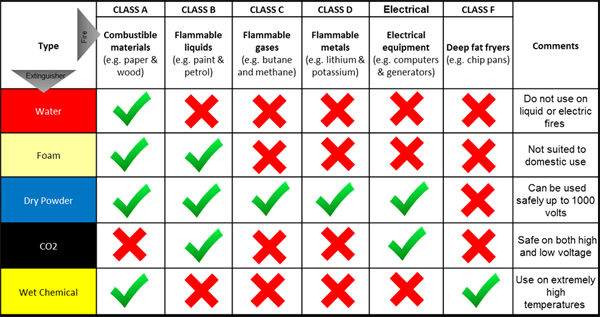
Types of fire extinguisher – a detailed guide
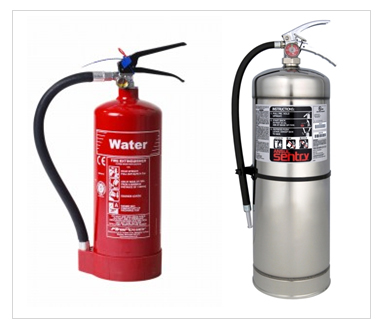
Water Extinguishers
Overview: Water extinguishers are the most common fire extinguisher type for class A fire risk. Most premises will require either water or foam extinguishers.
Label Colour: Bright Red
Use for:
Organic materials such as:
– Paper and cardboard
– Fabrics and textiles
– Wood and coal
Do not use for:
– Fires involving electrical equipment
– Kitchen fires
– Flammable gas and liquids
How water extinguishers work:
The water has a cooling effect on the fuel, causing it to burn much more slowly until the flames are eventually extinguished.
Types of premises/business who may need water extinguishers:
– Buildings constructed of wood or other organic materials
– Premises where there are organic materials to be found such as:
o Offices
o Schools
o Hospitals
o Residential properties
o Warehouses
In fact most buildings need either water or foam extinguishers.
Where to locate water extinguishers:
– By the exits on a floor where a Class A fire risk has been identified
Water spray extinguishers – what’s the difference?:
Water spray extinguishers are equipped with a spray nozzle, rather than a jet nozzle, meaning a greater surface area can be covered more quickly and the fire put out more rapidly.
Water mist extinguishers – what’s the difference?:
Water mist extinguishers have a different type of nozzle again which releases microscopic water particles. These particles ‘suffocate’ the fire and also create a wall of mist between the fire and the person using the extinguisher, reducing the feeling of heat.
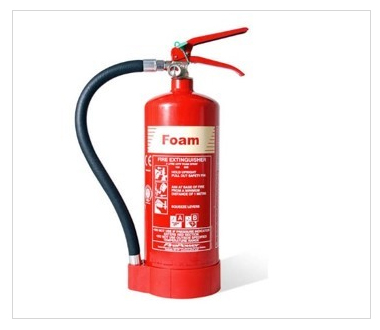
Foam Extinguishers
Overview:
Foam extinguishers are most common type of fire extinguisher for Class B fires, but also work on Class A fires as they are water-based.
Label Colour:
– Cream
Use for:
– Organic materials such as:
o Paper and cardboard
o Fabrics and textiles
o Wood and coal
Plus:
– Flammable liquids, like paint and petrol
Do not use for:
– Kitchen fires
– Fires involving electrical equipment
– Flammable metals
How foam extinguishers work:
As with water extinguishers, foam extinguishers have a cooling effect on the fuel. On burning liquids, the foaming agent creates a barrier between the flame and the fuel, extinguishing the fire.
Types of premises/business who may need Foam extinguishers:
– Buildings constructed of wood or other organic materials
– Premises where there are organic materials to be found such as:
o Offices
o Schools
o Hospitals
o Residential properties
o Warehouses
– Buildings where flammable liquids are stored
In fact most buildings need either water or foam extinguishers
Where to locate foam extinguishers:
– By the exits on a floor where a Class A or Class B fire risk has been identified
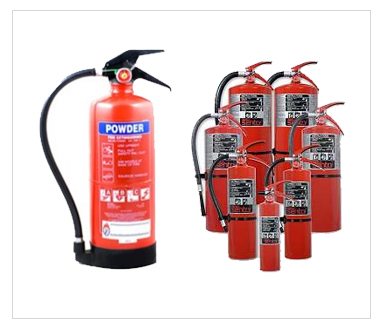
Dry Powder Extinguishers
Overview:
Standard dry powder extinguishers are also called ‘ABC’ extinguishers because they tackle class A, B and C fires, however they are not recommended for use in enclosed spaces. This is because the powder can be easily inhaled, and also the residue is very difficult to clean up after. ABC powder extinguishers can also be used on some electrical fires. Specialist dry powder extinguishers are used for flammable metals.
Label Colour:
– Blue
Use for:
– Organic materials such as:
o Paper and cardboard
o Fabrics and textiles
o Wood and coal
Plus:
– Flammable liquids, like paint and petrol
Plus:
– Flammable gases, like liquid petroleum gas (LPG) and acetylene
Plus:
– Fires involving electrical equipment up to 1000v
Specialist dry powder extinguishers are only used on flammable metals, such as titanium and magnesium.
Do not use for:
– Fires involving cooking oil
– Fires involving electrical equipment over 1000v
– or in enclosed spaces, such as offices or residential properties
How dry powder extinguishers work:
Dry powder extinguishers smother fires by forming a barrier between the fuel and the source of oxygen.
Types of premises/business who may need Dry Powder extinguishers:
– Businesses using flammable gases for chemical processes
– Premises where welding and flame cutting takes place
– Garage forecourts
– Liquid petroleum gas (LPG) dispensing plants
– Premises with large, commercial boiler rooms
Where to locate Dry Powder extinguishers:
– Place dry powder extinguishers near to the source of the fire risk.
Specialist Dry Powder extinguishers – Specialist dry powder extinguishers work in the same way as standard dry powder extinguishers but are for use with flammable metals only. There are 2 types of specialist dry powder extinguishers – ‘L2’ which only tackles lithium fires, and ‘M28’, for all other flammable metal fires.
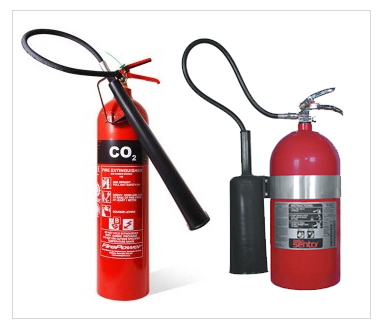
Carbon Dioxide (CO2) Extinguishers and Clean Agent Extinguishers
Overview:
CO2 extinguishers and Clean Agent extinguishers are predominantly used for electrical fire risks and are usually the main fire extinguisher type provided in computer server rooms. They also put out Class B fires (flammable liquids, such as paint and petroleum).
CO-2 is clean but subjects the item on fire to cold shock so is not advised for delicate electronics or other high value assets where freezing might due additional harm. The Clean agent fire extinguisher uses more a chemical reaction rather than cooling to fight the fire and is considered lower impact on sensitive electronics that might be on fire or near the fire.
Label Color:
– Black / Green
Use for:
– Flammable liquids, like paint and petrol
– Electrical fires
Do not use for:
– Kitchen fires – especially chip-pan fires
– Combustible materials like paper, wood or textiles
– Flammable metals
How CO2 extinguishers work:
CO2 extinguishers suffocate fires by displacing the oxygen the fire needs to burn.
Types of premises/business who may need CO2 extinguishers:
– Premises with electrical equipment, such as:
o Offices
o Kitchens
o Construction sites
o Server rooms
All work vehicles should also carry a smaller 2kg CO2 extinguisher.
Where to locate CO2 extinguishers:
– Place near to the source of the fire risk and/or near the fire exits.
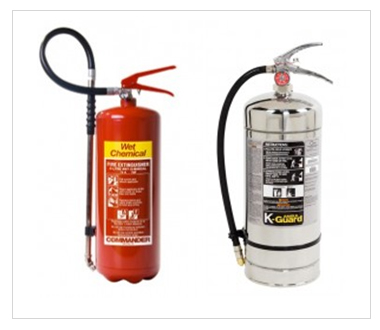
Wet Chemical Extinguishers Type K / F
Overview:
Wet chemical extinguishers are designed for use on Class F fires, involving cooking oils and fats. They can also be used on Class A fires although it is more usual to have a foam or water extinguisher for this type of fire risk.
Label Color:
– Yellowbr />Use for:
– Cooking oil/fat fires
– Organic materials such as:
o Paper and cardboard
o Fabrics and textiles
o Wood and coal
Do not use for:
– Flammable liquid or gas fires
– Electrical fires
– Flammable metals
How wet chemical extinguishers work:
Wet chemical extinguishers create a layer of foam on the surface of the burning oil or fat, preventing oxygen from fuelling the fire any further. The spray also has a cooling effect.
Types of premises/business who may need wet chemical extinguishers:
– Commercial kitchens
– Canteens
Where to locate wet chemical extinguishers:
– Place near to the source of the fire risk.
STYLES OF FIRE EXTINGUISHERS
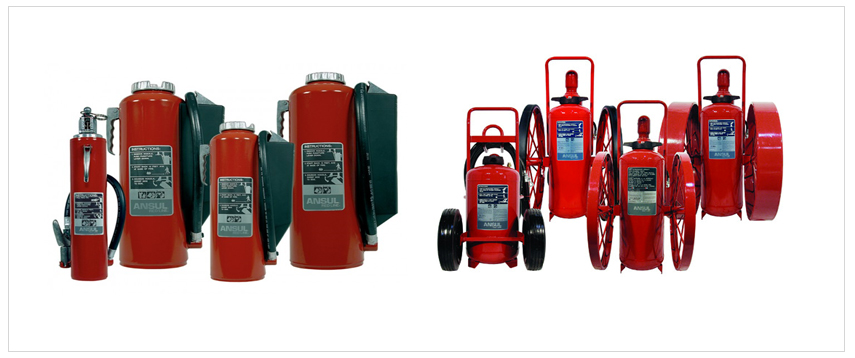
RED LINE CARTRIDGE-OPERATED HAND PORTABLES—DRY CHEMICAL
Red Line cartridge-operated fire extinguishers are the premium firefighting units preferred by safety directors worldwide in high fire-risk industries such as chemical, petro-chemical, oil and gas, mining, aviation, and power generation. Cartridge-operated means increased reliability, on-the-spot recharge, ease of service, and superior firefighting performance.
Typical applications include fuel loading racks, heavy construction sites, dip tanks, oil pumping stations, mining equipment, paint lockers, trucks and buses, fuel storage rooms, production lines and others. Tough, carbon steel shells resist impact, vibration and corrosion; quality components stand up to years of service; and special polyester powder paints provide superior protection against cracking and chipping.
SENTRY / Mobiak Fire Extinguishers are designed for protection of light and ordinary hazards. These compact and portable extinguishers are Stored Pressure type and are suited for both industrial and commercial fire protection needs.
Found virtually anywhere a general-purpose fire extinguisher is needed, these dry chemical / Wet Chemical extinguishers are ideal for auto repair shops, electrical equipment rooms, machining operations, material handling vehicles, banks, offices, schools, hotels, warehouses, and many other applications.
Both Styles of Fire Extinguisher ( Cartridge / Industrial and Store pressure ) can be used to fight different kinds and sizes of fires. See our helpful When and How to USE a Fire Extinguisher.
Understanding the type of hazard can help in understanding which type, Quality, and which Agent is best for your needs. Contact Thompson’s Specialties’ for Advice on Selecting the right Fire Extinguisher for your facilities.
Wheel Units:
RED LINE WHEELED UNITS DRY CHEMICAL RED LINE Wheeled dry chemical fire extinguishers are made specifically to protect people and property in areas where the potential for large-scale fires is always present. Airports, loading docks, steel and iron mills, paint spray booths, dip and quench tanks, offshore platforms, loading racks, fuel storage, and heavy manufacturing areas benefit from the protection offered by these industrial high-hazard fire extinguishers. These heavy-duty wheeled units have greater extinguishing agent capacities than hand portable fire extinguishers, yet are highly mobile and can be fully operated by one person. Large diameter steel wheels quickly and more easily move the unit to the source of the fire, while the quick-opening valve option allows for fast, one-step actuation. Wheeled extinguishers are available with dry chemical or special dry agent powders to provide maximum protection for many types of fire hazards. They also come with CO-2, Foam and other Agents depending on the Hazard they are protecting. Contact US the Experts in Fire Extinguisher and Wheel Unit selection to assist in understanding the needs of your facility.
